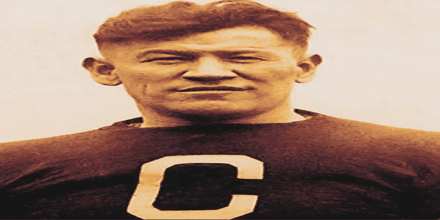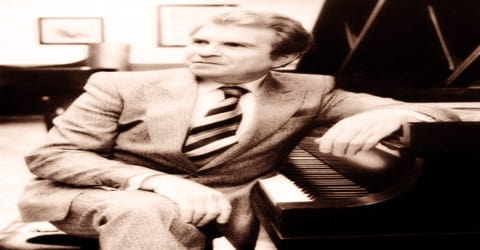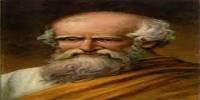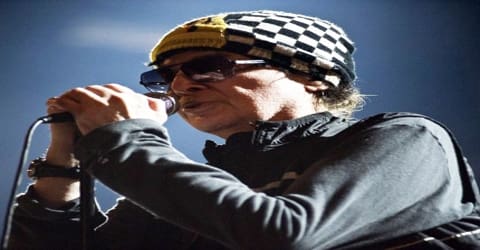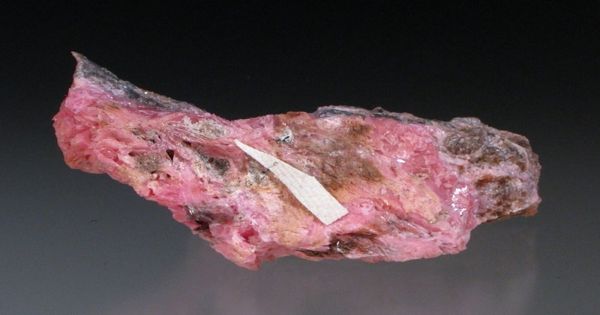Jim Thorpe – (C. 1887-1953)
(Famous Basketball, Hockey, Baseball, and Football Player, Athlete, Boxer)
Full Name: James Francis Thorpe
Date of birth: May 22 or 28, 1887
Place of birth: Near Prague, Oklahoma
Date of death: March 28, 1953 (aged 65)
Place of death: Lomita, California
Height: 6 ft 1 in (1.85 m)
Weight: 202 lb (92 kg)
Position: Back
Early Life
James Francis Thorpe was born on May 22 or 28, 1887, in Near Prague, Oklahoma. He was an American athlete and Olympic gold medalist. An All-American in football at the Carlisle Indian School, he won the pentathlon and decathlon at the 1912 Olympics before his gold medals were revoked on a technicality. Thorpe played professional baseball and football, and sought an acting career after retiring from sports.
A member of the Sac and Fox Nation, Thorpe became the first Native American to win a gold medal for his home country. Considered one of the most versatile athletes of modern sports, he won Olympic gold medals in the 1912 pentathlon and decathlon, played American football (collegiate and professional), and also played professional baseball and basketball. He lost his Olympic titles after it was found he had been paid for playing two seasons of semi-professional baseball before competing in the Olympics, thus violating the amateurism rules that were then in place. In 1983, 30 years after his death, the International Olympic Committee (IOC) restored his Olympic medals.
From 1920 to 1921, Thorpe was nominally the first president of the American Professional Football Association (APFA), which would become the National Football League (NFL) in 1922.
In a poll of sports fans conducted by ABC Sports, Thorpe was voted the Greatest Athlete of the Twentieth Century out of 15 other athletes including Muhammad Ali, Babe Ruth, Jesse Owens, Wayne Gretzky, Jack Nicklaus, and Michael Jordan.
After his victories at the Olympic Games in Sweden, on September 2, 1912, he returned to Celtic Park, the home of the Irish American Athletic Club, in Queens, New York, where he had qualified four months earlier for the Olympic Games, to compete in the Amateur Athletic Union’s All-Around Championship. Competing against Bruno Brodd of the Irish American Athletic Club and J. Bredemus of Princeton University, he won seven of the ten events contested and came in second in the remaining three. With a total point score of 7,476 points, Thorpe broke the previous record of 7,385 points set in 1909, (also set at Celtic Park), by Martin Sheridan, the champion athlete of the Irish American Athletic Club. Sheridan, a five-time Olympic gold medalist, was present to watch his record broken, approached Thorpe after the event and shook his hand saying, “Jim, my boy, you’re a great man. I never expect to look upon a finer athlete.” He told a reporter from New York World, “Thorpe is the greatest athlete that ever lived. He has me beaten fifty ways. Even when I was in my prime, I could not do what he did today.”
Until 2005, most of Thorpe’s biographers were unaware of his basketball career until a ticket discovered in an old book that year documented his career in basketball. By 1926, he was the main feature of the “World Famous Indians” of LaRue which sponsored traveling football, baseball and basketball teams. “Jim Thorpe and His World-Famous Indians” barnstormed for at least two years (1927–28) in parts of New York and Pennsylvania as well as Marion, Ohio. Although pictures of Thorpe in his WFI basketball uniform were printed on postcards and published in newspapers, this period of his life was not well documented.
Educational Career
Thorpe attended the Sac and Fox Indian Agency School in Stroud, Oklahoma, with his twin brother, Charlie. Charlie helped him through school until he succumbed to a bout of pneumonia when they were nine years old. He ran away from school several times. His father then sent him to the Haskell Institute, an Indian boarding school in Lawrence, Kansas, so that he would not run away again.
Thorpe learned to hunt and trap prey at an early age, developing his legendary endurance via extensive excursions through Indian Territory.
Career
As a student at Carlisle in the spring of 1907, Thorpe joined a track-and-field practice session on campus. Clad in his work clothes, he launched himself over a 5’9″ high bar to break the school record, catching the attention of coach Pop Warner. Thorpe soon became the star of the track program, and with his athletic skills he also enjoyed success in baseball, hockey, lacrosse and even ballroom dancing.
Pop Warner was hesitant to allow Thorpe, his best track and field athlete, to compete in a physical game such as football.
Thorpe gained nationwide attention for the first time in 1911. As a running back, defensive back, placekicker and punter, Thorpe scored all his team’s points—four field goals and a touchdown—in an 18–15 upset of Harvard, a top ranked team in those early days of the National Collegiate Athletic Association. His team finished the season 11–1. In 1912 Carlisle won the national collegiate championship largely as a result of his efforts – he scored 25 touchdowns and 198 points during the season.
Carlisle’s 1912 record included a 27–6 victory over Army. In that game, Thorpe’s 92-yard touchdown was nullified by a teammate’s penalty, but on the next play Thorpe rushed for a 97-yard touchdown.
Football was – and would remain – Thorpe’s favorite sport. He competed only sporadically in track and field, even though this turned out to be the sport in which he gained his greatest fame.
In the spring of 1912, he started training for the Olympics. He had confined his efforts to jumps, hurdles and shot-puts, but now added pole vaulting, javelin, discus, hammer and 56 lb weight. In the Olympic trials held at Celtic Park in New York, his all-round ability stood out in all these events and so he riveted a claim to a place on the team that went to Sweden.
Named to the U.S. team for the 1912 Olympic Games in Stockholm, Sweden, Thorpe burst out of the gate by winning four of five events to claim the gold medal in the pentathlon. A week later he overwhelmed the field in the decathlon, winning the high jump, the 110-meter hurdles and the 1,500 meters despite competing in a pair of mismatched shoes. Finishing the three-day event with a total of 8,412.95 points (of a possible 10,000), a mark that bested the runner-up by nearly 700 points, Thorpe was proclaimed by Sweden’s King Gustaf V to be the greatest athlete in the world.
According to his obituary in The New York Times he could run the 100-yard dash in 10 seconds flat, the 220 in 21.8 seconds, the 440 in 51.8 seconds, the 880 in 1:57, the mile in 4:35, the 120-yard high hurdles in 15 seconds, and the 220-yard low hurdles in 24 seconds. He could long jump 23 ft 6 in and high-jump 6 ft 5 in. He could pole vault 11 feet, put the shot 47 ft 9 in, throw the javelin 163 feet, and throw the discus 136 feet.
Thorpe was honored with a ticker-tape parade in New York City as part of his hero’s welcome home. However, a newspaper report the following January revealed that the Olympic champion had been paid to play minor league baseball in 1909 and 1910. Despite his handwritten plea to the Amateur Athletic Union, Thorpe was stripped of his amateur eligibility and forced to return his gold medals, his historic performance stricken from the Olympic record books.
He won four of the five events and placed third in the javelin, an event he had not competed in before 1912.
As was the custom of the day, the medals were presented to the athletes during the closing ceremonies of the games. Along with the two gold medals, Thorpe also received two challenge prizes, which were donated by King Gustav V of Sweden for the decathlon and Czar Nicholas II of Russia for the pentathlon. Several sources recount that, when awarding Thorpe his prize, King Gustav said, “You, sir, are the greatest athlete in the world”, to which Thorpe replied, “Thanks, King”. Contemporary sources from 1912 are lacking, suggesting that the story was apocryphal, however. The anecdote appeared in newspapers as early as 1948, 36 years after his appearance in the Olympics, and in books as early as 1952.
Apart from his track and field appearances, he also played in one of two exhibition baseball games at the 1912 Olympics, which featured two teams composed of U.S. track and field athletes. It was not Thorpe’s first try at baseball, as the public would soon learn.
In late January 1913, the Worcester Telegram published a story announcing that Thorpe had played professional baseball, and other U.S. newspapers followed up the story. Thorpe had indeed played professional baseball in the Eastern Carolina League for Rocky Mount, North Carolina, in 1909 and 1910, receiving meager pay; reportedly as little as US$2 ($51 today) per game and as much as US$35 ($890 today) per week. College players, in fact, regularly spent summers playing professionally but most used aliases, unlike Thorpe.
Although Thorpe had played for money, the AAU and IOC did not follow the rules for disqualification. The rulebook for the 1912 Olympics stated that protests had to be made “within” 30 days from the closing ceremonies of the games. The first newspaper reports did not appear until January 1913, about six months after the Stockholm Games had concluded.
There is also some evidence that Thorpe’s amateur status had been questioned long before the Olympics, but the AAU had ignored the issue until being confronted with it in 1913.
The only positive element of this affair for Thorpe was that, as soon as the news was reported that he had been declared a professional, he received offers from professional sports clubs.
Thorpe made a much bigger impact in the early stages of pro football. He signed with the Canton Bulldogs for $250 per game in 1915, justifying the price tag by drawing massive audiences and leading the team to league championships in 1916, ’17 and ’19. In 1920, the Bulldogs were among the 14 clubs that made up the American Professional Football Association – soon to be renamed the National Football League – with Thorpe serving as league president for a season.
In January 1913, he turned down a starting position with the American League cellar-dwelling St. Louis Browns, choosing instead to join the 1912 National League champion New York Giants, who, with Thorpe playing in 19 of their 151 games, would repeat as the 1913 National League champions. Immediately following the Giants’ October loss in the 1913 World Series, Thorpe and the Giants joined the Chicago White Sox for a world tour.
From 1922 to ’23, Thorpe coached and played for an all-Native American team called the Oorang Indians. Sponsored by Walter Lingo, owner of the Oorang Dog Kennels in LaRue, Ohio, the team’s games featured players performing “war dances” and other rituals to entertain audiences. Thorpe went on to play for the NFL’s Cleveland Indians, Rock Island Independents, New York Giants and Chicago Cardinals through 1928.
After playing in the minor leagues with the Milwaukee Brewers in 1916, he returned to the Giants in 1917 but was sold to the Cincinnati Reds early in the season. In the “double no-hitter” between Fred Toney of the Reds and Hippo Vaughn of the Chicago Cubs, Thorpe drove in the winning run in the 10th inning. Late in the season, he was sold back to the Giants. Again, he played sporadically for them in 1918 before being traded to the Boston Braves on May 21, 1919, for Pat Ragan. In his career, he amassed 91 runs scored, 82 runs batted in and a .252 batting average over 289 games. He continued to play minor league baseball until 1922.
He first played professional football in 1913 as a member of the Indiana-based Pine Village Pros, a team that had a several-season winning streak against local teams during the 1910s.
He then signed with the Canton Bulldogs in 1915. They paid him $250 ($5,858 today) a game, a tremendous wage at the time. Before signing him Canton was averaging 1,200 fans a game, but 8,000 showed up for his debut against the Massillon Tigers.
Personal Life
Thorpe was born in Indian Territory, but no birth certificate has been found. He was generally considered to have been born on May 22, 1887, near the town of Prague, Oklahoma. Thorpe himself said in an article in The Shawnee News-Star in 1949 that he was born May 28, 1888, on his mother’s allotment “near and south of Bellemont – Pottawatomie County – along the banks of the North Fork River … hope this will clear up the inquiries as to my birthplace.” However, most biographers believe that he was born on May 22, 1887, as that is what is listed on his baptismal certificate. Bellemont was a small community, now disappeared, on the line between Pottawatomie and Lincoln Counties. While the town of Prague, Lincoln County, now claims to be the birthplace of Thorpe, there is no evidence that Thorpe himself called Prague his hometown. All his personal references were either Shawnee (the county seat of Pottawatomie County and about ten miles (16 km) southwest of his birthplace) or “Pott County”. The Sac and Fox agency is in Stroud, Lincoln County, which could cause some of the confusion.
Thorpe’s parents were both of mixed-race ancestry. His father, Hiram Thorpe, had an Irish father and a Sac and Fox Indian mother. His mother, Charlotte Vieux, had a French father and a Potawatomi mother, a descendant of Chief Louis Vieux. He was raised as a Sac and Fox, and his native name, Wa-Tho-Huk, translated as “path lit by great flash of lightning” or, more simply, “Bright Path”. As was the custom for Sac and Fox, he was named for something occurring around the time of his birth, in this case the light brightening the path to the cabin where he was born. Thorpe’s parents were both Roman Catholic, a faith which Thorpe observed throughout his adult life.
When his mother died of childbirth complications two years later, he became depressed. After several arguments with his father, he left home to work on a horse ranch.
In 1904 the sixteen-year-old Thorpe returned to his father and decided to attend Carlisle Indian Industrial School in Carlisle, Pennsylvania. There his athletic ability was recognized and he was coached by Glenn Scobey “Pop” Warner, one of the most influential coaches of early American football history. Later that year he became orphaned after Hiram Thorpe died from gangrene poisoning after being wounded in a hunting accident, and Jim again dropped out of school. He resumed farm work for a few years and then returned to Carlisle Indian Industrial School.
Thorpe married three times and had eight children (one of whom died in childhood). In 1913 Thorpe married Iva M. Miller, whom he had met at Carlisle. In 1917 Iva and Thorpe bought a house now known as the Jim Thorpe House in Yale, Oklahoma, and lived there until 1923. They had four children: Gail Margaret (October 31, 1917 – June 3, 2005), James F. (May 8, 1918 – September 28, 1919), Charlotte Marie (September 16, 1919 – December 8, 1998) and Grace Frances (December 10, 1921 – April 1, 2008). Miller filed for divorce from Thorpe in 1925, claiming desertion.
In 1926 Thorpe married Freeda Verona Kirkpatrick (September 19, 1905 – March 2, 2007). She was working for the manager of the baseball team for which he was playing at the time. They had four sons: Carl Phillip (May 1, 1927 – March 18, 1986), a lieutenant colonel in the U.S. Army, William K., Richard A. and John R. “Jack” (June 29, 1937 – February 22, 2011). Kirkpatrick divorced Thorpe in 1941 after 15 years of marriage.
Lastly, Thorpe married Patricia Gladys Evelyn “Patsy” Askew (née Woodbury) on June 2, 1945; she was with him when he died.
Legacy and Burial Controversy
Thorpe was elected a charter member of the Pro Football Hall of Fame in 1963, and in 1982 his name was restored to the Olympic record books as a co-winner of the 1912 track events. Proving he still loomed large in the American consciousness, he was voted the previous century’s greatest athlete in a 2000 ABC Sports poll, and finished third in another ballot conducted by the Associated Press.
In 2010, Thorpe’s son Jack filed a federal lawsuit to bring his father’s remains back to Oklahoma. A trial court judge originally sided in the family’s favor, but in 2014 a federal appeals court overturned that ruling. The following year, the U.S. Supreme Court declined to hear another appeal, thus maintaining Jim Thorpe, Pennsylvania, as the athlete’s final resting spot.
Death
In early 1953, Thorpe went into heart failure for the third time while dining with Patricia in their home in Lomita, California. He was briefly revived by artificial respiration and spoke to those around him, but lost consciousness shortly afterward and died on March 28 at the age of 65.
Honours
Thorpe’s monument, featuring the quote from Gustav V (“You, sir, are the greatest athlete in the world.”), still stands near the town named for him, Jim Thorpe, Pennsylvania. The grave rests on mounds of soil from Thorpe’s native Oklahoma and from the stadium in which he won his Olympic medals.
Thorpe’s achievements received great acclaim from sports journalists, both during his lifetime and since his death.
In 1950 an Associated Press poll of almost 400 sportswriters and broadcasters voted Thorpe the “greatest athlete” of the first half of the 20th century. That same year, the Associated Press named Thorpe the “greatest American football player” of the first half of the century.
In 1999, the Associated Press placed him third on its list of the top athletes of the century, following Babe Ruth and Michael Jordan. ESPN ranked Thorpe seventh on their list of best North American athletes of the century.
Thorpe was inducted into the Pro Football Hall of Fame in 1963, one of seventeen players in the charter class. Thorpe is memorialized in the Pro Football Hall of Fame rotunda with a larger-than-life statue. He was also inducted into halls of fame for college football, American Olympic teams, and the national track and field competition.
President Richard Nixon, as authorized by U.S. Senate Joint Resolution 73, proclaimed Monday, April 16, 1973, as “Jim Thorpe Day” to promote the nationwide recognition of Thorpe. In 1986, the Jim Thorpe Association established an award with Thorpe’s name. The Jim Thorpe Award is given annually to the best defensive back in college football. The annual Thorpe Cup athletics meeting is named in his honor. The United States Postal Service issued a 32¢ stamp on 3 February 1998 as part of the Celebrate the Century stamp sheet series.
In 2015 proposed designs for the 2018 Native American dollar coin featuring Thorpe were released.
Filmography
In the 1930s, Thorpe appeared in several short films and features. Usually, his roles were cameo appearances as an Indian, although in the 1932 comedy, Always Kickin, Thorpe was prominently cast in a speaking part as himself, a kicking coach teaching young football players to drop-kick. In 1931, during the Great Depression, he sold the film rights to his life story to MGM for $1,500 ($23,000 today). The movie included archival footage of the 1912 and 1932 Olympics, as well as a banquet in which Thorpe was honored. Thorpe was seen in some long shots in the film; and one scene showed him as a coaching assistant. It was also distributed in the United Kingdom, where it was called Man of Bronze.
Thorpe had a cameo appearance in the 1940 film Knute Rockne, All American. Late in the film, he tells Pat O’Brien (playing Knute Rockne) at the halftime of a game, “Two minutes, Rock!” He is referenced by O’Brien earlier in the film, as a player you could build a team around. He played a member of the Navajo band in the 1950 film Wagon Master.
Thorpe was memorialized in the Warner Bros. film Jim Thorpe – All-American (1951) starring Burt Lancaster, with Billy Gray performing as Thorpe as a child. The film was directed by Michael Curtiz. Although there were rumors that Thorpe received no money, he was paid $15,000 by Warner Bros. plus a $2,500 donation toward an annuity for him by the studio head of publicity.
He is mentioned twice in Disney’s 1973 film The World’s Greatest Athlete.
Thorpe is featured as a ghost figure in the 1994 film WindRunner: A Spirited Journey, where he is portrayed by Russell Means.
